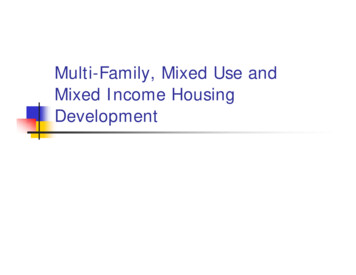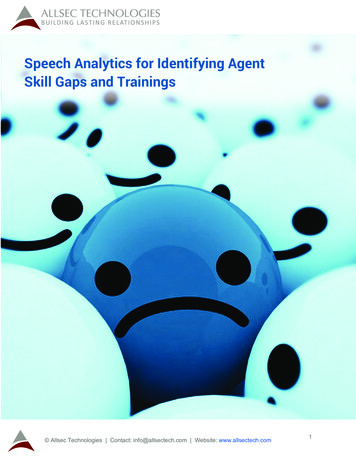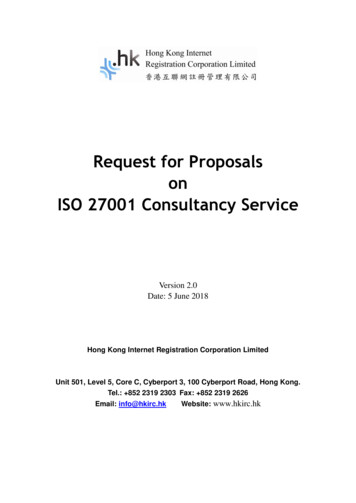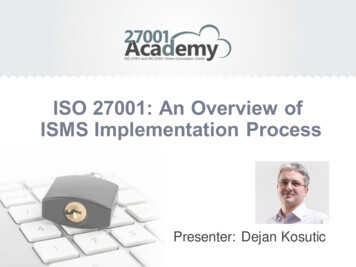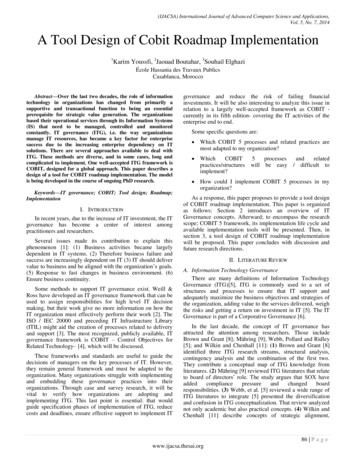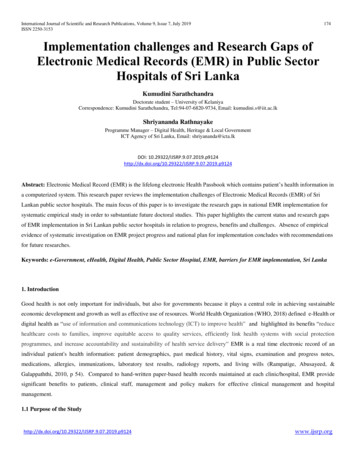
Transcription
International Journal of Scientific and Research Publications, Volume 9, Issue 7, July 2019ISSN 2250-3153174Implementation challenges and Research Gaps ofElectronic Medical Records (EMR) in Public SectorHospitals of Sri LankaKumudini SarathchandraDoctorate student – University of KelaniyaCorrespondence: Kumudini Sarathchandra, Tel:94-07-6820-9734, Email: kumudini.s@iit.ac.lkShriyananda RathnayakeProgramme Manager – Digital Health, Heritage & Local GovernmentICT Agency of Sri Lanka, Email: shriyananda@icta.lkDOI: .29322/IJSRP.9.07.2019.p9124Abstract: Electronic Medical Record (EMR) is the lifelong electronic Health Passbook which contains patient’s health information ina computerized system. This research paper reviews the implementation challenges of Electronic Medical Records (EMR) of SriLankan public sector hospitals. The main focus of this paper is to investigate the research gaps in national EMR implementation forsystematic empirical study in order to substantiate future doctoral studies. This paper highlights the current status and research gapsof EMR implementation in Sri Lankan public sector hospitals in relation to progress, benefits and challenges. Absence of empiricalevidence of systematic investigation on EMR project progress and national plan for implementation concludes with recommendationsfor future researches.Keywords: e-Government, eHealth, Digital Health, Public Sector Hospital, EMR, barriers for EMR implementation, Sri Lanka1. IntroductionGood health is not only important for individuals, but also for governments because it plays a central role in achieving sustainableeconomic development and growth as well as effective use of resources. World Health Organization (WHO, 2018) defined e-Health ordigital health as “use of information and communications technology (ICT) to improve health” and highlighted its benefits “reducehealthcare costs to families, improve equitable access to quality services, efficiently link health systems with social protectionprogrammes, and increase accountability and sustainability of health service delivery” EMR is a real time electronic record of anindividual patient's health information: patient demographics, past medical history, vital signs, examination and progress notes,medications, allergies, immunizations, laboratory test results, radiology reports, and living wills (Rampatige, Abusayeed, &Galappaththi, 2010, p 54). Compared to hand-written paper-based health records maintained at each clinic/hospital, EMR providesignificant benefits to patients, clinical staff, management and policy makers for effective clinical management and hospitalmanagement.1.1 Purpose of the 124www.ijsrp.org
International Journal of Scientific and Research Publications, Volume 9, Issue 7, July 2019ISSN 2250-3153175This study aims to study overall EMR implementations in Sri Lankan public sector hospitals and identify the progress so far, benefitsof implementation and challenges. It intends to identify the research gaps and propose recommendations with direction for futureresearch.1.2 MethodologyThis paper uses deductive approach to arrive conclusions by interpreting the meanings of findings from literature and interviews. Journalarticles and publications were reviewed from online libraries and databases. Preliminary interviews were conducted with medicalprofessionals who are involved and not involved in EMR implementations and ICTA digital health project managers.2. Literature SurveyHealth is central to human happiness and well-being thus it makes an important contribution to economic progress, productive andhealthy population. There are many players to support health care in a country such as government organizations, non-governmentorganizations, private sector health organizations, donor organizations, civil society groups and communities (WHO, 2018a).The health care system of a country can be grouped to two distinct sectors: public sector – government health care system and privatesector health care system. In Sri Lanka, public sector health care system facilities are provided free of charge while private sectorsystems are on payment based.The cost of health services is increasing thus health care organizations and citizens have to make health financing arrangements toensure that people are not denied access to essential health services because they cannot afford it. As per the World Bank statistics theglobal health expenditure (% of GDP) in 2016 as 10.02 while United States having very high 17.07 and Sri Lanka’s score is at thelowest end: 3.89 (World Bank Group, 2019)Thus finding innovative methods to provide better health care facilities with minimumcost has become very important for hospitals and governments. Digital Health helps to address the health problems and challengesfaced by patients and helps reduce inefficiencies and costs in healthcare delivery, whilst also improving access, incr easing quality,and making medicine more personalized and precise (Kelly, 2017). The most endorsed digital health technologies are ElectronicMedical Records (EMR), computerized provider order entry (CPOE), eChanneling, ePrescribing and computerized decision supportsystems (CDSS) due to their financial and clinical benefits (Scott, Pillans, Barras, & Morris, 2018).2.1 Electronic Medical Records (EMR)EMR sometimes referred to Electronic Health Record (EHR) is a real time electronic record of an individual patient's health information:patient demographics, past medical history, vital signs, examination and progress notes, medications, allergies, immunizations,laboratory test results, radiology reports, and living wills (Rampatige et al., 2010). During past three decades, a number of differentforms of EMRs have been developed and implemented in developed and developing countries while other countries are currently in theprocess of planning and implementing EMR systems (WHO, 2006). Effective EMR implementations help achieving a comprehensiveset of information providingcontinuity of patient care, at the right time, right place and right cost. This will not only facilitate toprovide timely healthcare, but also prevent duplication of investigations, medications, delay in care, risk and reduce cost (Mogli, 2012).Many patients receive services from separate facilities (clinics and hospitals) and care providers thus the value of individual patient datafor improved patient care is efficient and effective if the electronic record system could compile these data and make them accessibleto other health care professionals (World Health Organization, 9124www.ijsrp.org
International Journal of Scientific and Research Publications, Volume 9, Issue 7, July 2019ISSN 2250-31531762.2 EMR in Sri LankaIntroduction to digital health initiative in Sri Lanka has started in 1997 and many organizations: Ministry of Health, Nutrition &Indigenous Medicine, the Specialty Board in Biomedical Informatics, Redcross, Post Graduate Institute of Medicine (PGIM, the HealthInformatics Society of Sri Lanka has contributed to its evolution (Health Informatics Society of Sri Lanka, 1998). The multi-diseasesurveillance software (MDS) has developed locally for the Ministry of Healthcare and Nutrition in collaboration with the support fromWorld Health Organization which was initially developed for healthcare in the US and implemented in a small hospital (ChenkaladyRural Hospital) in February 2007 then the first large hospital (Batticaloa Teaching Hospital) in April 2007 (Pole, 2010). The nationalEMR system in Sri Lanka is Hospital Health Information Management System (HHIMS) which started in 2010 and had successful pilotimplementations in different hospitals: Dompe District hospital, Dambadeniya Base Hospital, Avissawella base hospital and Mahaoyabase hospital. The Open-source version of HHIMS version 1 was implemented for the Regional Director of Health Services, Kegallethrough the partnership with Information Communication Technology Agency (ICTA) in 2010 (HISSL, 2018), (Rathnayaka, 2019).Ministry of Health, Nutrition & Indigenous Medicine planned to implement this system in 47 hospitals in 2016, 100 hospitals in 2017,and 150 hospitals in 2018 (Ministry of Health, 2017).2.2.1 Current ProgressThe current EMR implementations in public sector (non-profit organizations) has provided significant cost benefits (Amarasiri &Dorabawila, 2018b), (Hewapathirana & Rathnayake, 2014). The four basic cost reductions were found: costs for stationeries, patientqueue waiting time, supporting staff number and indirect costs such as drug balancing. The majority of economic benefits of EMRhave been evaluated through Cost Benefit Analysis (CBA) techniques ( Soo, Baik, & Lyul, 2013), (Karl, Tom, Alexander, & Veli N,2006). A Sri Lankan research study also indicated that Health care professionals, supporting staff and patients had a positive perceptionon EMR systems (Amarasiri & Dorabawila, 2018b).An evaluation report of ICTA shows that 52% of users find that there is hassle free quality health care services while another 35% ofclients and 67% of users find that better quality in in treating patient (Management Frontiers (Pvt) Ltd, 2015). The usability andacceptance of EMR has been recorded satisfactory (Pole, 2010), (Rathnayake & Hewapathirana, 2009), (Jeyakodi & Herath, 2016), .The current EMR solution only covers the Out Door Patient Department (OPD) and its related sections although there is provision inthe system to implement it other departments such as wards, blood bank, etc. It was planned to implement the EMR system in 300hospitals during 2016 to 2018 however, only 50 hospitals (15%) have been implemented in mid-2019 (Rathnayaka, 2019). Ministryof Health plans to issue e-Health cards for all Sri Lankans by 2020 (DailyFT, 2018), however there is no national plan for its realization.The current status of EMR implementation is stagnated.2.3 Implementation barriersImplementation of EMR has been very challenging and many barriers have been identified in developed and developing countries:Holistic approach, Aversion to change, legal complication, privacy concerns, Security issues, technical barriers, inter-operability,Leadership, Coordination among stakeholders, resistance to use, incentives and knowledge of IT. (Eden, Burton-Jones, Scott, Staib, &Sullivan, 2018),(Alkhaldi, Sahama, Huxley, & Gajanayake, 2014),(Zayyad & Toycan, 2018) (Kaye, Kokia, Shalev, Idar, & Chinitz,2010), (Mandirola , et al., 2015), (Kaduruwane, 124www.ijsrp.org
International Journal of Scientific and Research Publications, Volume 9, Issue 7, July 2019ISSN 2250-3153177Further, Williams & Suzanne, 2014 highlighted that converting from a paper-based to an EMR system is complex and difficult becauseit represents a paradigm shift for the work of physicians and other staff. The transition requires a systematic activity and must bemanaged from many aspects ‘clinically, administratively, culturally, and organizationally. The transition must include not only theprocess changes inherent in the use of a new tool, but also the technical and procedural training, and the resultant changes to physicianand staff roles within the office. Subsequently, it requires a strong management commitment and motivation. Secondly, involvement ofall stakeholders, care providers and other users of the system right from the beginning is necessary for survival and sustenance of theproject. Involving the stakeholders will help them to have a clear understanding of why the organization is making the change.One research findings indicated that there are many independent e-Health systems implemented in Sri Lanka without proper centralcoordination(Wanniarachchi, Wanasinghe, Gamage, & Gunesekera, 2014). The main barrier of e-Health implementations isunavailability of national Health Implementation policy to drive the e-Health projects. Lack of research on eHealth related projects,inadequate central coordination, current compartmentalization among key stake holders have been identified as other barriers(Rathnayaka, 2019).2.4 Gaps identified in EMR implementationsGap 1 –Limited scientific research on EMRThe scientific research on EMR is limited in developing countries (Bedeley, 2014). Very few research articles were found in Sri LankanEMR Implementations. Most of them evaluate the user acceptance using Technology Adaptation Model (TAM) (Edirisinghe, 2017),(Fernando, 2018) or Unified Theory of Acceptance and use of Technology (UTAUT) Model (Jeyakodi & Herath, 2016). The economicvalue of EMRs have been quantified by different researches and confirmed that EMR helps to avoid duplicate tests, reduce adverse drugevents and achieve other benefits resulted in 1.3 billion in benefits between 2006 – 2012 (Canda Health Infoway, 2015). However,there is limited economic evaluation studies available in developing countries and suggests the greater need for economic evaluation ofeHealth interventions in developing countries (Bogale, Leon, & Louwrence, 2018). Importance of policies in implementing EMR andHealth Managers’ Trust also have been studied (Hewapathirana & Rathnayake, 2014; Indika Jagoda, Samiddhi Samarakoon, 2014;Rathnayake & Hewapathirana, 2009). There have been few researches on EMR success stories of EMR implementation (Syed Rehan,2018), (Rathnayake & Hewapathirana, 2009), (Jeyakodi & Herath, 2016), (Amarasiri & Dorabawila, 2018a).Gap 2 – National policy to implement EMR in all departments/hospitals and national Integrated EMRMinistry of Health (2017) identified issues in implementing digital health projects “A one-system-for-all model may not be acceptableto all providers; flexibility may be required as core data required for primary care consultations is identified, Need to identify theconnections in terms of data sharing, Integration of existing systems in the private sector”. Currently the outdoor patient records arecomputerized in few hospitals and there is not connectivity among them thus the planned benefits of one health card concept is not yetpossible to achieve. Margunn Aanestad (2011) indicated the building of nation-wide information infrastructures in healthcare throughmodular implementation strategies is important. Another research has highlighted the importance of national policies for successfulimplementation of country-wide digital health system (Jagoda , Samarakoon, & Rathnayaka). The Sri Lanka’s digital health policy isstill at a draft 9124www.ijsrp.org
International Journal of Scientific and Research Publications, Volume 9, Issue 7, July 2019ISSN 2250-3153178Gap 3 – Data Ownership, Data security and PrivacyThere are over 3 million patient records already available in different hospitals. Ministry of Health has identified the need of propermaintenance of this large data set ensuing data security and privacy (Ministry of Health Sri Lanka, 2016). However, the routineInformation Systems audit and empirical researches on this security area are not evident to assure the data protection.Gap 4 – Data analytics and decision makingThe true value for healthcare stems from providing the best level of care for patients based on well-analyzed data and predictions.The evaluation report has recommended to include data mining tools and business intelligent tools enabling decision support system(DSS) for the health sector at the provincial and national levels (Management Frontiers Limited, 2015). Thus the study on how thispatient data could be used for better health care need to be studied.ConclusionEMR is a real time electronic record of patient's health information which can reduce healthcare costs to families, improve equitableaccess to quality services, and efficiently link health systems with social protection programmes, and increase accountability andsustainability of health service delivery. During past three decades, a number of different forms of EMRs have been implemented indeveloped and developing countries while other countries are currently in the process of planning and implementing EMR systems. SriLankan public health sector has made significant efforts in implementing a national EMR systems however, it is now stagnated withouta national plan. Researchers and implementers have identified several barriers such as coordination, leadership, interoperability, Privacy,Security, national policy, lack of empirical research, etc. Therefore it is important to conduct a systematic empirical research to findout these barriers and develop a national policy/framework which will be instrumental for policy makers to expedite this nationalimplementation of EMR in Sri 9124www.ijsrp.org
International Journal of Scientific and Research Publications, Volume 9, Issue 7, July 2019ISSN 2250-3153179ReferencesDailyFT. (2018, April 20). SL digital healthcare model plays pivotal role in healthcare delivery benefitting over 3 m. DailyFT.Gunatilleke, N. (2018, April 17). e-Health cards for all by 2020 - Rajitha. DailyNews.H.A.D.B., A., & Dorabawila, S. (2018). Does Electronic Medical Records make cost benefits to non-profit seeking health careinstitutes? International Journal of Scientific and Research Publications,.Health Connect International. (2014). ICT for Health. Retrieved from Health Connect International: h Informatics Society of Sri Lanka. (1998). Digital Health in Sri Lanka 1998 - 2018. Colombo Sri Lanka: Health InformaticsSociety of Sri Lanka.Health.Enabled. (2018, April). Global Health Index - Sri Lanka. Retrieved from Global Health Index :http://index.digitalhealthindex.org/country profile/LKAHISSL. (2018a). Short History of Health Informatics in Sri Lanka and the Health Informatics Society of Sri Lanka (HISSL). Retrievedfrom HISSL: https://hissl.lk/history/ICTA . ( 2017, October 30). Official Launch of Digital Health Project and Distribution of Hardware for 48 Government Hospitals forImplementing Electronic Medical Records. Retrieved from ICTA : -medical-records/ICTA. (2018, December 19). ICTA - eHealth. Retrieved from ICTA SriLanka: https://www.icta.lk/our-future/health/Jayawardana, A. S. (2014 ). The Electronic Hospital Information System Implemented at the District General Hospital TrincomaleeAn Experience of Business Process Reengineering. Journal of Community Medicine Health Education .Jeyakodi, T., & Herath, D. (2016). Acceptance and Use of Electronic Medical Records in Sri Lanka. Scientific Research Journal(SCIRJ) .Ministry of Health. ( 2013, November 17). eHealth Policy, Strategy, Guidelines and Standards. Retrieved from Regional High LevelMeeting on eHealth, Bangkok:http://www.searo.who.int/entity/health situation trends/events/03 Sri Lanka Country Experience Strategic Area 1.pdfMinistry of Health . (2013). NATIONAL HEALTH STRATEGIC MASTER PLAN 2016 - 2025. Colombo: Ministry of Health.Ministry of Health - Sri Lanka. (2016). National Strategic Framework For Development of Health Services 2016 - 2025. Colombo:Ministry of Health, Nutrition & Indigenous Medicine - Sri Lanka.Ministry of Health - Sri Lanka. (2016a). NATIONAL HEALTH STRATEGIC MASTER PLAN 2016 - 2025 - Vol II - PreventiveServices. Sri Lanka: Ministry of Health - Sri Lanka.Ministry of Health. (2016). National eHealth Guidelines. colombo : Health Information Unit Management Development and PlanningUnit.Ministry of Health. (2016a). NATIONAL HEALTH STRATEGIC MASTER PLAN 2016 - 2025 - Vol. IV - Health Administration &HRH. Colombo: Ministry of Health.Ministry of Health. (2017). Reorganising Primary Health Care in Sri Lanka - PRESERVING OUR PROGRESS, PREPARING OURFUTURE. Colombo: http://www.health.gov.lk/.Ministry of Health. (2018, December 20). OUR VISION. Retrieved from Minstry of Health :http://www.health.gov.lk/moh final/english/others.php?spid 26Ministry of Telecommunication & Digital Infrastruture. (2017). Performance Report 2017. Colombo: Ministry of Telecommunication& Digital 7.2019.p9124www.ijsrp.org
International Journal of Scientific and Research Publications, Volume 9, Issue 7, July 2019ISSN 2250-3153180Ministry of Telecommunication & Digital Infrastructure . (2016). Perofrmance Report. Colombo: Ministry of Telecommunication &Digital Infrastructure .Nishantha, G. (2009, April 3). Towards a sustainable e-health deployment An integrated medical information system for Sri Lankancase. 2009 3rd International Conference on Pervasive Computing Technologies for Healthcare. London, UK: IEEE.Retrieved from IEEE Explore Digital Library: 200OECD Data. (2018). Health spending. Retrieved from Organisation for Economic Co-operation and Development - ng.htmRamesh Govindaraj, K. N. (2014). HEALTH CARE IN SRI LANKA: What Can the Private Health Sector Offer? USA: The worldbank.Rathnayaka, S. (2019, January 3). Current digital health implementation issues in Sri Lanka . (K. Sarathchandra, Interviewer)Rathnayake , S., & Hewapathirana, R. (n.d.). IMPACT OF ELECTRONI: HEALTH RECORDS IN SRI LANKA - CASE STUDYOF FOUR GOVERNMENT HOSPITALS. Cmb.Academia.edu.Siriwardana, D. N. (2018, December 15). EHR implementation at Maharagama Hospital. (K. Sarathchandra, Interviewer)Soyza, I. D. (2018, December 30). Project Manager - ICTA. (K. Sarathchandra, Interviewer)Sunday Island. (2018, April 19 ). Sri Lanka’s digital healthcare model benefitting over three million. The Island - Online.The World Bank. (2018). Current health expenditure (% of GDP) - 2016. Retrieved from The World HEX.GD.ZSUNITED NATIONS. (2018). UNITED NATIONS E-GOVERNMENT SURVEY 2018. New York: publicadministration.un.org.Wanniarachchi, A., Wanasinghe, D., Gamage, U., & Gunesekera, A. (2014). A Meta-Analysis of Public Sector E-Health Practices tosuggest emerging areas of eHealth services within Sri Lanka. Kothalawala Defence International Confererence Engineering (pp. 55-60). Colombo: KDU.WHO. (2016). Monitoring and Evaluating Digital Health Interventions. Geneva: WHO.WHO. (2018, December 19). eHealth at WHO. Retrieved from World Health Organization: https://www.who.int/ehealth/about/en/ :Accessed on 4th April 2019WHO. (2018a, December 19). Health and development. Retrieved from World Health Organization: https://www.who.int/hdp/en/:Accessed on 5th April 2019World Health Organization. (2012). Management of Patient Information - Trends and Challenges in Member countries. Switzerland:World Health .2019.p9124www.ijsrp.org
of Health plans to issue e-Health cards for all Sri Lankans by 2020 (DailyFT, 2018), however there is no national plan for its realization. The current status of EMR implementation is stagnated. 2.3 Implementation barriers Implementation of EMR has been very challenging and many barriers have been identified in developed and developing countries:
